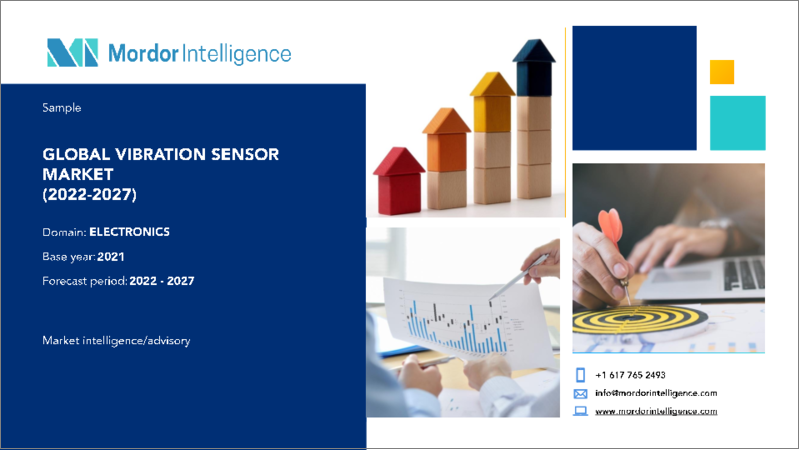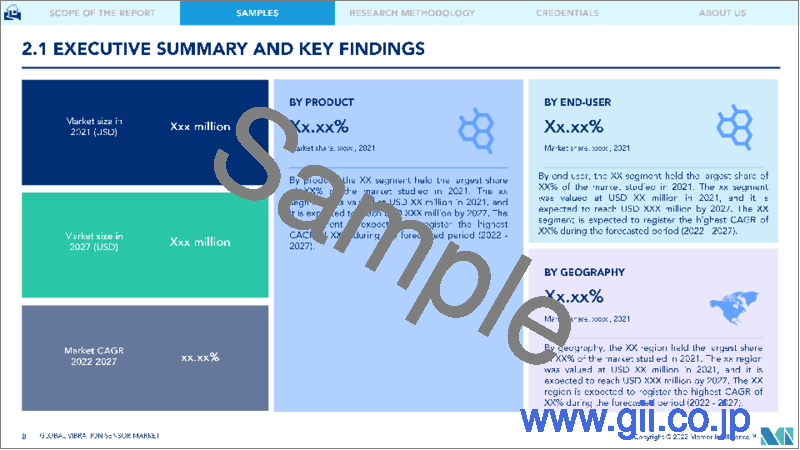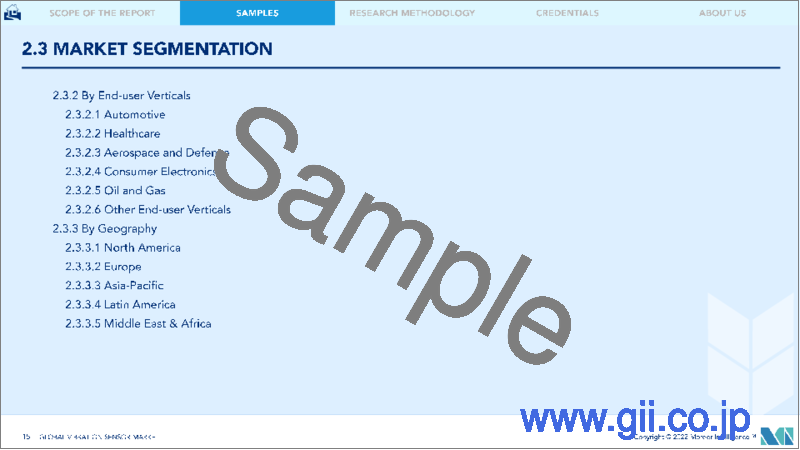|
|
市場調査レポート
商品コード
1137191
振動センサーの市場- 成長、動向、予測(2022年~2027年)Vibration Sensor Market - Growth, Trends, and Forecasts (2022 - 2027) |
||||||
|
● お客様のご希望に応じて、既存データの加工や未掲載情報(例:国別セグメント)の追加などの対応が可能です。 詳細はお問い合わせください。 |
|||||||
| 振動センサーの市場- 成長、動向、予測(2022年~2027年) |
|
出版日: 2022年10月13日
発行: Mordor Intelligence
ページ情報: 英文 120 Pages
納期: 2~3営業日
|
- 全表示
- 概要
- 目次
振動センサー市場は、予測期間中に7.3%のCAGRで推移すると予想されています。
様々な産業分野において、機械やその他の重要な機器の振動を監視・分析することは、予知保全プログラムの非常に重要な部分となってきています。典型的なアプリケーションでは、インボードとアウトボードのモーターベアリングの両方で、水平、垂直、アキシャル方向の振動測定が要求されます。
主なハイライト
- 競争が激化する産業市場では、よりスマートな工具を製造するための新しい機能が求められており、さまざまなコンポーネントの状態を監視することが基本的なニーズとなっています。このため、予測期間中に振動センサーの需要が高まると予想されます。
- インダストリー4.0の登場により、組織は自動化と機械や装置の消耗を早期に発見することができる予知保全に力を入れ始めています。このため、予測期間中、このようなセンサーの採用が進むと予想されます。
- 2022年3月、Flussoは世界最小の空気速度センサーを発表しました。FLS122のフットプリントはわずか3.5×3.5mmで、現在の最小の競合デバイスよりも80%小さくなっています。フルソのFLS122センサは、スペースに制約のある厳しい環境下での熱管理およびフィルタ監視のための基板実装型気流速測定用に特別に設計されています。
- また、ここ数年、振動センサーの需要が高まっており、特に古い機器との互換性の問題が、市場に影響を与える大きな課題として認識されています。
- さらに、2022年3月には、ハイテク精密機器のサプライヤーであるSpectris plcが、圧電素子およびMEMSベースの加速度計およびセンサーの設計・製造の大手であるDytran Instrumentsの買収を発表しています。この8200万米ドルの買収により、両社は相互補完的な能力を活用し、顧客サービスの向上と製品開発の加速を図ることができます。
- 加速度センサを使用するスマートフォン、ウェアラブル、スマート家電、埋め込み型または摂取型の医療機器などのスマートデバイスの採用が進んでいることが、予測期間中の振動センサー市場の成長を促進すると予想されます。
- 例えば、2022年3月、サムスンは新しいGalaxy Aシリーズスマートフォンを発売しました。オクタコアプロセッサがSamsung Galaxy A53 5Gを搭載しています。リフレッシュレート120Hz、6.50インチのタッチスクリーンディスプレイを搭載し、解像度1080×2400ピクセル、ピクセル密度407ピクセル/インチで提供します。さらに、Samsung Galaxy A53 5Gのコネクティビティオプションは、Wi-Fi 802.11 a/b/g/n/ac, GPS, Bluetooth v5.10, NFC, USB Type-C, 3G, 4G, 5Gを備えています。搭載センサーは、加速度センサー、環境光センサー、コンパス/地磁気センサー、ジャイロスコープ、近接センサー、ディスプレイ内指紋センサーなど。
- また、振動ジャイロセンサは、自動車の電子安定制御システム、カーナビゲーションシステム、モバイルゲームのモーションセンシング、デジタルカメラの手ぶれ検出システム、ロボットシステム、ラジコンヘリコプターなどにも広く採用されています。MEMSジャイロは、低コスト、小型・軽量であることから、ここ数年、スマートフォンの普及に伴い、大きな成功を収めています。
- また、COVID-19の発生により、世界のサプライチェーンと複数の製品の需要に混乱が生じました。また、中国での生産停止により、多くの産業で各種製品の供給不足が発生しています。しかし、市場ベンダーは企業へのサービス提供を試みており、収益の確保に貢献しています。
主な市場動向
航空宇宙・防衛分野のエンドユーザーが大きなシェアを獲得
- オペレーションを推進するための状況認識の向上、費用対効果の高いメンテナンス、資産の活用などが、航空機ヘルスモニタリングシステムの需要を高める主な要因となっています。
- さらに、2021年3月には、国立技術研究所(NIST)の研究者が、オプトメカニカルとレーザーの原理に基づく新型の加速度センサを開発しました。このセンサーは1組のシリコンチップで構成されており、宇宙船や航空機、自動運転車、タブレット、スマートフォンなどで利用される可能性があり、市場の成長をさらに後押しするものと思われます。
- アジアをはじめ、英国、欧州、ドイツなどの主要な航空市場では、旅客数や航空機の移動量が伸びており、予測期間中の市場の牽引役となることが予想されます。
- 例えば、ボーイング社によると、インドの民間航空サービス産業の市場規模は2040年までに3兆7,000億米ドルに達し、今後20年間で新たに2,200機の民間航空機に対する需要が生まれると予想されています。その結果、航空業界の拡大により、振動センサーの需要が増加し、予測期間中の市場を牽引することが予想されます。
- タービンエンジンの故障は機械的故障の主な原因であり、コストを増大させます。したがって、これらの損失を防止し、メンテナンスコストを削減するために、ユーザーは予後健康管理(PHM)システムにますます注目するようになっています。振動は航空宇宙エンジン産業において最も一般的なヘルスモニタリングパラメータであるため、PHMシステムの開発は振動センサーの成長に直接影響を与える可能性があります。
アジア太平洋地域は欧州地域で大きなシェアを占めるようになる
- アジア太平洋地域は、最大の航空宇宙産業の本拠地です。IBEFによると、インドの航空宇宙・防衛(A&D)市場は、2030年までに700億米ドルに達すると予測されています。
- 先進の振動センサーは、航空機のロータートラック&バランス(RT&B)のような過酷なアプリケーションに使用されています。また、航空機の設計や試験にも利用され、DCレスポンス(静的)およびACレスポンス(動的)タイプの加速度ピックアップが提供されています。
- インドでは、家電製品の成長により、家電製品に組み込まれる振動センサーが増加しています。さらに、India Brand Equity Foundation(IBEF)によると、インドの家電・民生機器(ACE)市場は年率9%を記録し、2022年には3兆1500億インドルピー(483億7000万米ドル)に達すると予想されています。これにより、予測期間中の振動センサー市場の成長が促進されると予想されます。
- また、国内での石油需要の増加により、ニーズを満たすための現地精製所や探査サイトの増加が見込まれ、石油・ガス産業における振動センサーの需要を後押ししています。
- 製造業は、同国で高い成長を示している分野の1つとして浮上しています。インド首相が意欲的に推進している「Make in India」プログラムは、インドを主要な製造拠点として位置づけ、インド経済を世界的に認知させることを目的としており、製造分野における自動化やスマートテクノロジーの導入を促進すると期待されています。
- さらに、インド中央政府が所有するIndian Oil Corporationは、2030年までに石油精製能力を25%増強するために70,000カロールインドルピーを投資する計画を発表しており、インド国内の高まるエネルギー需要に率先して応えていく方針です。このように、他の企業(民間)による潜在的な投資が、同国の振動センサーの需要を促進する態勢を整えています。
競合情勢
振動センサーの市場は断片的です。新規参入組が消費者へのアプローチに課題を抱えている中、確立されたブランドアイデンティティを持つ世界なセンサメーカーが市場に存在することは、競争企業間の敵対関係に大きな影響を与えると予想されます。ブランドアイデンティティは、購入者の行動を決定する上で強い役割を果たします。したがって、知名度の高い企業は、市場の他のプレイヤーに対してかなりの優位性を持っています。主要なプレーヤーには、Texas Instruments、Honeywell、Emersonなどがあります。
- 2021年 10月-TE Connectivityは、ハイブリッドおよび電気商用輸送市場向けに3つの新製品を発表しました。新しいIPT-HDパワーボルトコネクタは、-40~+125℃の温度範囲で性能を発揮し、低接触抵抗設計によりエンジンレベルの過度の振動に耐えることができます。
- 2021年5月-STマイクロエレクトロニクスは、次世代MEMS3軸リニア加速度センサ「AIS2IH」の発売を発表しました。この加速度センサは、テレマティクス・インフォテインメントなどの車載アプリケーションにおいて、温度安定性、分解能、機械的堅牢性を向上させる可能性を持っています。人工知能(AI)やモノのインターネット(IoT)などの先端技術の振動センサーへの統合が進むことで、新たな市場機会が開かれます。
その他の特典
- エクセル形式の市場予測(ME)シート
- 3ヶ月間のアナリストサポート
目次
第1章 イントロダクション
- 調査の前提条件と市場の定義
- 調査対象範囲
第2章 調査手法
第3章 エグゼクティブサマリー
第4章 マーケットインサイト
- 市場概要
- 産業の魅力- ポーターズファイブフォース分析
- 供給企業の交渉力
- 買い手の交渉力
- 新規参入業者の脅威
- 代替品の脅威
- 競争企業間の敵対関係
- 産業バリューチェーン分析
- COVID-19の業界への影響評価
第5章 市場の力学
- 市場促進要因
- 機械状態監視とメンテナンスのニーズの高まり
- スマートマニュファクチャリングと産業用IoTの採用の拡大
- 市場の課題
- 需要のボラティリティ
第6章 市場セグメンテーション
- 製品別
- 加速度センサ
- 速度センサ
- 非接触型変位計
- その他の製品
- エンドユーザー業界
- 自動車
- ヘルスケア
- 航空宇宙・防衛
- コンシューマーエレクトロニクス
- 石油・ガス
- その他のエンドユーザー産業
- 地域別情報
- 北米
- 米国
- カナダ
- 欧州
- ドイツ
- 英国
- フランス
- その他欧州
- アジア太平洋地域
- 中国
- インド
- 日本
- その他アジア太平洋地域
- ラテンアメリカ
- ブラジル
- アルゼンチン
- メキシコ
- その他のラテンアメリカ地域
- 中東・アフリカ
- アラブ首長国連邦
- サウジアラビア
- 南アフリカ共和国
- その他の中東・アフリカ地域
- 北米
第7章 競合情勢
- 企業プロファイル
- SKF GmbH
- Bosch Sensortec GmbH(Robert Bosch GmbH)
- Honeywell International Inc.
- Emerson Electric Corporation
- Texas Instruments Incorporated
- National Instruments Corporation
- Rockwell Automation Inc.
- NXP Semiconductors NV
- TE Connectivity Ltd
- Hansford Sensors Ltd
- Analog Devices Inc.
第8章 投資分析
第9章 市場の将来性
The vibration Sensor Market is expected to register a CAGR of 7.3% during the forecast period. Monitoring and analyzing vibrations of machines or other critical equipment in various industrial sectors have become a very crucial part of the predictive maintenance program. Typical applications demand vibration measurements in the horizontal, vertical, and axial directions on both the inboard and outboard motor bearings.
Key Highlights
- In an increasingly competitive industrial market, where new features are required to produce ''smarter'' tools, monitoring the condition of various components has become a fundamental need. This is expected to boost the demand for vibration sensors over the forecast period.
- With the advent of industry 4.0, organizations have started being more bent on automation and predictive maintenance that allows them to prematurely detect the wear and tear in the machines and equipment. This is expected to boost the adoption of such sensors over the forecast period.
- In March 2022, Flusso announced the world's smallest air velocity sensor. The FLS122 has a footprint of only 3.5 by 3.5 mm, making it 80% smaller than today's smallest competitive device. Flusso's FLS122 sensor was designed specifically for board-mounted air velocity measurements for thermal management and filter monitoring in some of the most space-constrained and challenging environments.
- In addition, the demand for vibration sensors has been rising for the last few years, and compatibility concerns, especially with old equipment, have been identified as major challenges affecting the market.
- Furthermore, in March 2022, Spectris plc, a supplier of high-tech precision instruments, announced the acquisition of Dytran Instruments, a leading designer and manufacturer of piezo-electric and MEMS-based accelerometers and sensors. The USD 82 million deal will enable both companies to leverage complementary capabilities to improve customer offerings and accelerate product development.
- The increasing adoption of smart devices, such as smartphones, wearables, smart appliances, and implantable or ingestible medical devices, among others that use accelerometers, is expected to drive the growth of the vibration sensors market over the forecast period.
- For instance, in March 2022, Samsung launched the new Galaxy A-series Smartphone. An octa-core processor powers Samsung Galaxy A53 5G. It has a 120 Hz refresh rate and 6.50-inch touchscreen display, offering a resolution of 1080×2400 pixels at a pixel density of 407 pixels per inch. In Addition, Connectivity options on the Samsung Galaxy A53 5G include Wi-Fi 802.11 a/b/g/n/ac, GPS, Bluetooth v5.10, NFC, USB Type-C, 3G, 4G, and 5G. Sensors on the phone include an accelerometer, ambient light sensor, compass/ magnetometer, gyroscope, proximity sensor, and in-display fingerprint sensor.
- Vibration gyroscope sensors are also widely adopted for electronic stability control systems of vehicles, car navigation systems, motion-sensing for mobile games, camera-shake detection systems in digital cameras, robotic systems, radio-controlled helicopters, etc. In the last few years, smartphones have witnessed MEMS gyroscopes' great success, owing to their low-cost, miniature size, and lightweight.
- Furthermore, owing to the COVID-19 outbreak, the global supply chain and demand for multiple products have experienced disruption. Moreover, due to the production shutdown in China, numerous industries have observed a supply shortage of various products. However, market vendors are trying to provide services to enterprises, which is helping them get revenues.
Key Market Trends
Aerospace & Defense End User to Hold Significant Share
- Increased situational awareness to drive operations, cost-effective maintenance, and asset utilization are some of the key factors driving the demand for aircraft health monitoring systems.
- Moreover, in March 2021, the National Institute of Technology (NIST) researchers developed a new type of accelerometer based on opting mechanical and lasers principles. This sensor consists of a pair of silicon chips and could find use in spacecraft and aircraft, self-driving cars, tablets, and smartphones, which will further drive the market growth.
- The passenger traffic in Asia and other major aviation markets, such as the United Kingdom, Europe, and Germany, has witnessed growth in terms of the number of passengers and aircraft movements, which is expected to drive the market during the forecast period.
- For instance, according to Boeing, the market size of India's commercial aviation services industry is expected to witness 3.7 trillion U.S. dollars by 2040, creating demand for an additional 2,200 new commercial aircraft in the next 20 years. As a result, the expanding airline industry is expected to increase the demand for vibration sensors, driving the market during the forecast period.
- Turbine engine failures are the primary cause of mechanical failures, increasing costs; hence, users are increasingly turning to prognostic health management (PHM) systems to prevent these losses and reduce maintenance costs. As vibration is the most common health monitoring parameter in the aerospace engine industry, the development of PHM systems is likely to directly impact the growth of vibration sensors.
Asia Pacific to Hold Significant Share in Europe Region
- The Asia Pacific is home to the largest aerospace industry. According to IBEF, The Indian aerospace & defense (A&D) market is projected to reach USD 70 billion by 2030.
- Advanced vibration sensors are used for harsh applications, like aircraft rotor track and balance (RT&B). They also serve applications in aircraft design and testing, offering DC-response (static) and AC-response (dynamic) types of accelerometers.
- The growth of consumer electronics in the country has led to a rise in vibration sensors being integrated into appliances. Furthermore, according to the India Brand Equity Foundation (IBEF), the Indian appliances and consumer electronics (ACE) market is expected to register a 9% CAGR to reach INR 3.15 trillion (USD 48.37 billion) in 2022. This is expected to boost the vibration sensors market growth over the forecast period.
- In addition, the increase in demand for oil in the country is expected to lead to a rise in local refineries and exploration sites to fulfill the need, thus driving the demand for vibration sensors in the oil and gas industry.
- Manufacturing has emerged as one of the sectors showing high growth in the country. The country's Prime Minister's ambitious 'Make in India' program, meant to position India as a leading manufacturing hub and give global recognition to the Indian economy, is expected to drive the adoption of automation and smart technologies in the manufacturing sector.
- Furthermore, The Indian Oil Corporation, owned by the Central Government of India, announced its plans to invest INR 70,000 crore to further increase its oil refining capacity by 25% by 2030, as it takes the lead in meeting the rising energy needs of the country. Thus, such potential investments by other players (private) are poised to drive the vibration sensors demand in the country.
Competitive Landscape
The vibration sensor market is fragmented. The presence of global sensor manufacturers with established brand identities in the market is expected to profoundly influence the intensity of competitive rivalry as new entrants face challenges in reaching out to consumers. Brand identity plays a strong role in determining buyer behavior. Therefore, well-known companies have a considerable advantage over other players in the market. Some of the key players are Texas Instruments, Honeywell, and Emerson.
- October 2021 - TE Connectivity has launched three new products for the hybrid and electric commercial transportation market. The new IPT-HD power bolt connector performs in temperatures ranging from -40 to +125 degrees Celsius, and its low-contact-resistance design can withstand excessively high engine-level vibrations.
- May 2021 - STMicroelectronics has announced the release of the AIS2IH, a next-generation MEMS three-axis linear accelerometer. This accelerometer has the potential to improve temperature stability, resolution, and mechanical robustness in automotive applications such as telematics infotainment. The increasing integration of advanced technologies such as Artificial Intelligence (AI) and the Internet of Things (IoT) in vibration sensors opens up new market opportunities.
Additional Benefits:
- The market estimate (ME) sheet in Excel format
- 3 months of analyst support
TABLE OF CONTENTS
1 INTRODUCTION
- 1.1 Study Assumptions and Market Definition
- 1.2 Scope of the Study
2 RESEARCH METHODOLOGY
3 EXECUTIVE SUMMARY
4 MARKET INSIGHTS
- 4.1 Market Overview
- 4.2 Industry Attractiveness - Porters Five Forces Analysis
- 4.2.1 Bargaining Power of Suppliers
- 4.2.2 Bargaining Power of Buyers
- 4.2.3 Threat of New Entrants
- 4.2.4 Threat of Substitutes
- 4.2.5 Intensity of Competitive Rivalry
- 4.3 Industry Value Chain Analysis
- 4.4 Assessment of Impact of COVID-19 on the Industry
5 MARKET DYNAMICS
- 5.1 Market Drivers
- 5.1.1 Increasing Need for Machine Condition Monitoring and Maintenance
- 5.1.2 Growing Adoption of Smart Manufacturing and Industrial IoT
- 5.2 Market Challenges
- 5.2.1 Volatility in Demand
6 MARKET SEGMENTATION
- 6.1 By Product
- 6.1.1 Accelerometers
- 6.1.2 Velocity Sensors
- 6.1.3 Non-contact Displacement Transducers
- 6.1.4 Other Products
- 6.2 End User Industry
- 6.2.1 Automotive
- 6.2.2 Healthcare
- 6.2.3 Aerospace and Defence
- 6.2.4 Consumer Electronics
- 6.2.5 Oil and Gas
- 6.2.6 Other End User Industries
- 6.3 By Geography
- 6.3.1 North America
- 6.3.1.1 United States
- 6.3.1.2 Canada
- 6.3.2 Europe
- 6.3.2.1 Germany
- 6.3.2.2 United Kingdom
- 6.3.2.3 France
- 6.3.2.4 Rest of Europe
- 6.3.3 Asia Pacific
- 6.3.3.1 China
- 6.3.3.2 India
- 6.3.3.3 Japan
- 6.3.3.4 Rest of the Asia Pacific
- 6.3.4 Latin America
- 6.3.4.1 Brazil
- 6.3.4.2 Argentina
- 6.3.4.3 Mexico
- 6.3.4.4 Rest of the Latin America
- 6.3.5 Middle East & Africa
- 6.3.5.1 United Arab Emirates
- 6.3.5.2 Saudi Arabia
- 6.3.5.3 South Africa
- 6.3.5.4 Rest of the Middle East & Africa
- 6.3.1 North America
7 COMPETITIVE LANDSCAPE
- 7.1 Company Profiles
- 7.1.1 SKF GmbH
- 7.1.2 Bosch Sensortec GmbH (Robert Bosch GmbH)
- 7.1.3 Honeywell International Inc.
- 7.1.4 Emerson Electric Corporation
- 7.1.5 Texas Instruments Incorporated
- 7.1.6 National Instruments Corporation
- 7.1.7 Rockwell Automation Inc.
- 7.1.8 NXP Semiconductors NV
- 7.1.9 TE Connectivity Ltd
- 7.1.10 Hansford Sensors Ltd
- 7.1.11 Analog Devices Inc.




